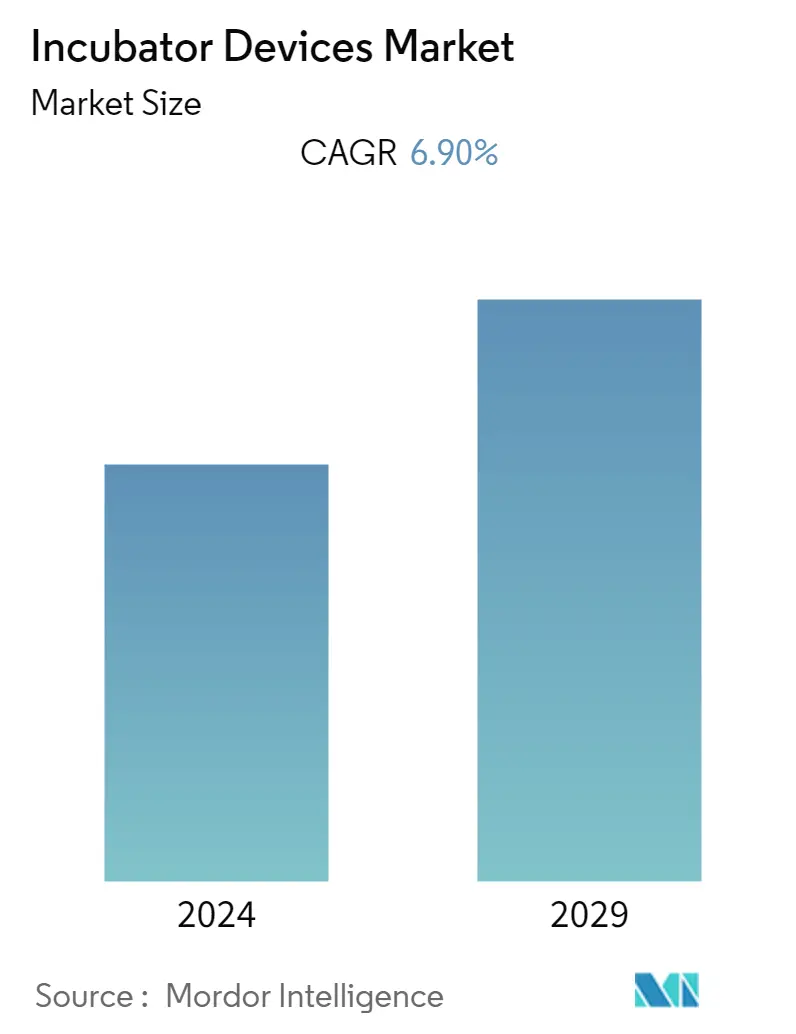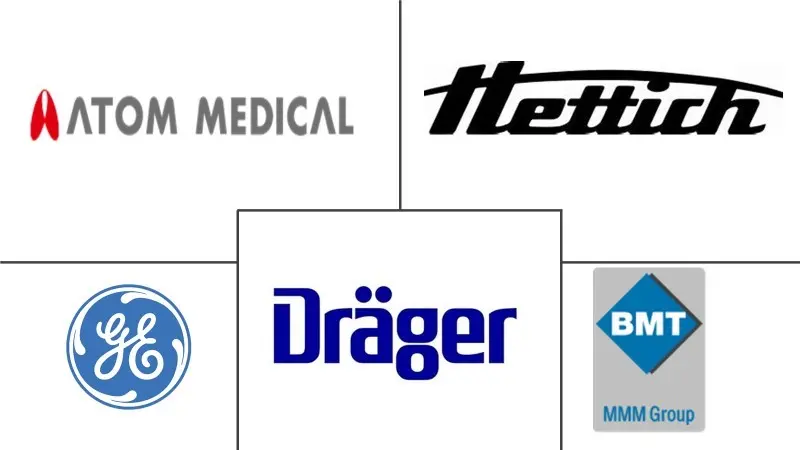Market Size of Incubator Devices Industry

| Study Period | 2019 - 2029 |
| Base Year For Estimation | 2023 |
| Forecast Data Period | 2024 - 2029 |
| CAGR | 6.90 % |
| Fastest Growing Market | Asia Pacific |
| Largest Market | North America |
Major Players
*Disclaimer: Major Players sorted in no particular order |
Incubator Devices Market Analysis
The incubator devices market is expected to register a CAGR of 6.9% during the forecast period.
COVID-19 significantly impacted the market's growth as the adverse effects caused by COVID-19 and the increase in preterm births drove the demand for incubator devices. As per the article published by JAMA in August 2021, women with COVID-19 were more likely to have preterm birth compared to women without COVID-19. Such risks of preterm birth during the pandemic are expected to drive the market's growth. The increasing demand for incubators during the pandemic period was most likely due to the preservation of test samples for COVID-19. According to the Division of Cambridge Innovation Institute data published in May 2021, recognizing the need for COVID-19 PCR test samples, high-end microbiology incubators provide the precise temperature control necessary for effective heat activation and incorporate advanced design features that enhance laboratory safety and usability. Such benefits offered by incubators contributed to the growth of the market during the pandemic period. However, there were already a large number of incubators acquired by end users, such as hospitals, laboratories, and others, during the pandemic period. Hence, it is expected to have a slight decrease in demand for incubators post-pandemic. Furthermore, the demand for incubators is expected to grow in the coming years and is expected to reach pre-pandemic levels in the next five years.
Certain factors driving the incubator devices market growth include the rising prevalence of premature babies, low birth weight of babies, and growing R&D in healthcare.
In the past decade, the rise in the prevalence of premature babies increased the demand for incubators in the market. According to the CDC report published in May 2022, the preterm birth rate in the United States was 10.48% in 2021. Such incidences of preterm births are expected to drive the demand for incubator devices, thereby contributing to market growth during the forecast period.
Also, increasing product launches are expected to contribute to market growth. For instance, in August 2021, Thermo Fisher Scientific launched a CO2 incubator that combines optimal cell growth capabilities with certified cleanroom capability, addressing the growing need for biotechnology.
Thus, the above-mentioned factors are expected to contribute to the market growth during the forecast period. However, the lack of awareness in emerging economies and the high cost of incubators are expected to restrain the market growth during the forecast period.
Incubator Devices Industry Segmentation
Incubators are devices that facilitate the growth of an organism by providing it with optimum temperature and environment. Thus, an incubator helps weak or small premature babies to survive. It comprises a transparent container in which the temperature and oxygen levels can be controlled. It can also refer to a piece of equipment that can be used to keep eggs or bacteria at the correct temperature to develop properly.
The incubator devices market is segmented by product type (neonatal incubators (portable or transport incubatory, open box incubators, close box incubators, and double-walled incubators), microbiological incubators, and other product types), end users (hospitals and birthing centers, diagnostic labs, and other end users), and geography (North America, Europe, Asia-Pacific, Middle East, and Africa, and South America). The market report also covers the estimated market sizes and trends for 17 countries across major global regions. The report offers the value (in USD million) for the above segments.
| By Product Type | ||||||
| ||||||
| Microbiological Incubators | ||||||
| Other Product Types |
| By End User | |
| Hospitals and Birthing Centers | |
| Diagnostic Labs | |
| Other End Users |
| Geography | ||||||||
| ||||||||
| ||||||||
| ||||||||
| ||||||||
|
Incubator Devices Market Size Summary
The incubator devices market is poised for significant growth, driven by factors such as the rising prevalence of preterm births and advancements in healthcare research and development. The demand for incubators surged during the COVID-19 pandemic, primarily due to the increased incidence of preterm births among infected women and the need for precise temperature control in microbiology labs for COVID-19 test sample preservation. This heightened demand, however, led to a saturation of the market as many end users, including hospitals and laboratories, acquired a substantial number of devices. Despite a potential post-pandemic dip in demand, the market is expected to rebound and reach pre-pandemic levels, supported by ongoing product innovations and a focus on reducing infant mortality rates through advanced medical devices.
In North America, the incubator devices market is bolstered by a well-developed healthcare infrastructure, high healthcare expenditure, and a significant number of preterm births, particularly in the United States and Canada. The presence of key manufacturers and the availability of advanced technologies further contribute to market expansion in this region. The market is moderately competitive, with major players like GE Healthcare, Drägerwerk AG & Co. KGaA, and Thermo Fisher Scientific Inc. holding substantial shares. Innovative product launches, such as Thermo Fisher Scientific's CO2 incubator and Cook Medical's MINC+ benchtop incubator, are expected to drive growth. However, challenges such as high costs and lack of awareness in emerging economies may restrain market progress.
Incubator Devices Market Size - Table of Contents
-
1. MARKET DYNAMICS
-
1.1 Market Overview
-
1.2 Market Drivers
-
1.2.1 Rising Prevalence of Premature Babies
-
1.2.2 Low Birth Weight of Babies
-
1.2.3 Growing R&D in Healthcare
-
-
1.3 Market Restraints
-
1.3.1 High Cost of Incubators
-
1.3.2 Lack of Awareness in Emerging Economies
-
-
1.4 Porter's Five Forces Analysis
-
1.4.1 Threat of New Entrants
-
1.4.2 Bargaining Power of Buyers/Consumers
-
1.4.3 Bargaining Power of Suppliers
-
1.4.4 Threat of Substitute Products
-
1.4.5 Intensity of Competitive Rivalry
-
-
-
2. MARKET SEGMENTATION (Market Size by Value - USD million)
-
2.1 By Product Type
-
2.1.1 Neonatal Incubators
-
2.1.1.1 Portable or Transport Incubator
-
2.1.1.2 Open Box Incubator
-
2.1.1.3 Close Box Incubator
-
2.1.1.4 Double Walled Incubator
-
-
2.1.2 Microbiological Incubators
-
2.1.3 Other Product Types
-
-
2.2 By End User
-
2.2.1 Hospitals and Birthing Centers
-
2.2.2 Diagnostic Labs
-
2.2.3 Other End Users
-
-
2.3 Geography
-
2.3.1 North America
-
2.3.1.1 United States
-
2.3.1.2 Canada
-
2.3.1.3 Mexico
-
-
2.3.2 Europe
-
2.3.2.1 Germany
-
2.3.2.2 United Kingdom
-
2.3.2.3 France
-
2.3.2.4 Italy
-
2.3.2.5 Spain
-
2.3.2.6 Rest of Europe
-
-
2.3.3 Asia-Pacific
-
2.3.3.1 China
-
2.3.3.2 Japan
-
2.3.3.3 India
-
2.3.3.4 Australia
-
2.3.3.5 South Korea
-
2.3.3.6 Rest of Asia-Pacific
-
-
2.3.4 Middle East and Africa
-
2.3.4.1 GCC
-
2.3.4.2 South Africa
-
2.3.4.3 Rest of Middle East and Africa
-
-
2.3.5 South America
-
2.3.5.1 Brazil
-
2.3.5.2 Argentina
-
2.3.5.3 Rest of South America
-
-
-
Incubator Devices Market Size FAQs
What is the current Incubator Devices Market size?
The Incubator Devices Market is projected to register a CAGR of 6.90% during the forecast period (2024-2029)
Who are the key players in Incubator Devices Market?
Andreas Hettich GmbH & Co.KG, Atom Medical Corporation, Drägerwerk AG & Co. KGaA, GE Healthcare and BMT Medical Technology sro are the major companies operating in the Incubator Devices Market.

